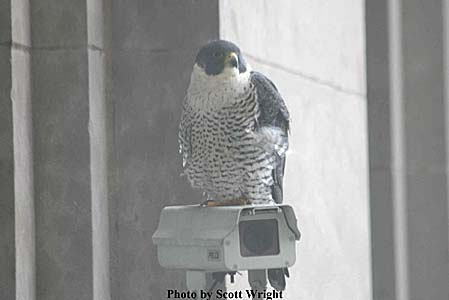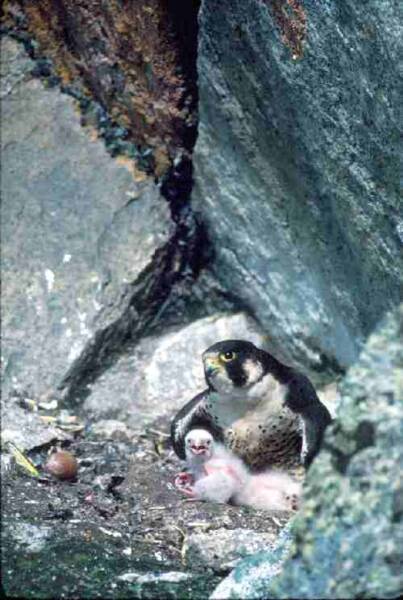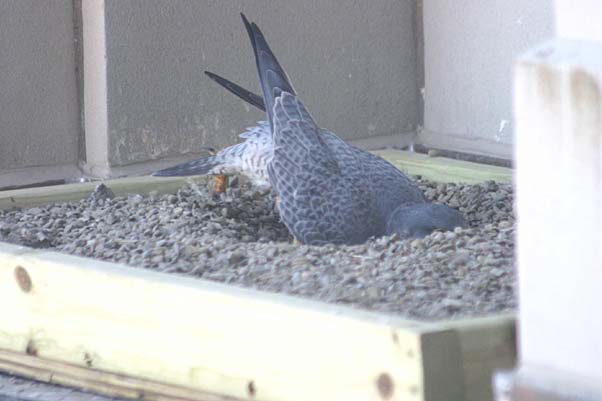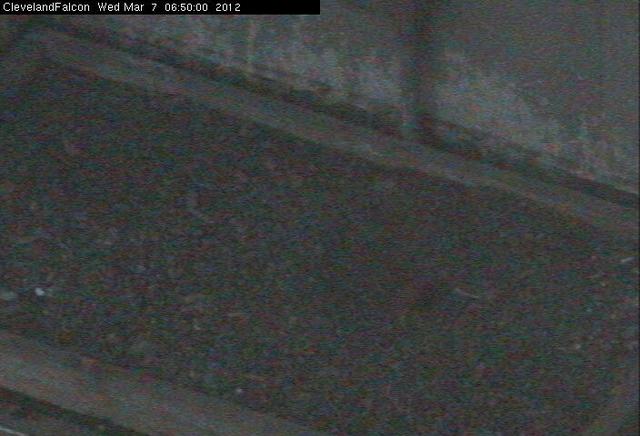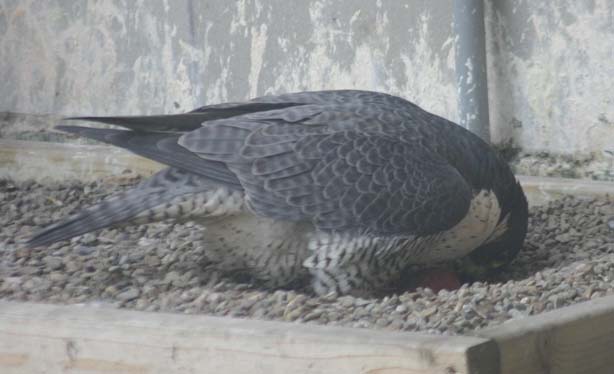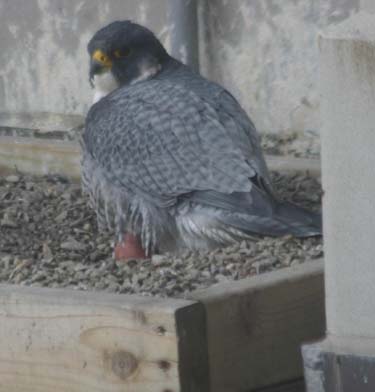FALCON FLASH
Dateline: Cleveland, Ohio
March 7, 2012
Click here to read what happened earlier
Volunteer nest monitor, Mr. Wright, watched the birds shortly after the first egg arrived and sent this picture of SW and her first egg. Notice how carefully she tucks the precious egg into the nest gravel.
Then Boomer came to the nestbox to take over nest-sitting duties for a while.
SW and Boomer, like many other peregrine couples, nest on a skyscraper. However, throughout most of their natural history, peregrine falcons have nested on high, remote cliff ledges that are difficult to reach. The nestsite or "eyrie" (also spelled "aerie") really is not a nest but a shallow depression, or "scrape," in the rocks and soil. Peregrines like to nest in the same place year after year, and there are cliffs in England where peregrines have nested for over 700 years. The following photo from the U.S. Fish and Wildlife Service shows what a peregrine nestsite looks like on a rocky cliff.
As humans began to build skyscrapers in the 20th century, peregrines adapted to the cliff-like buildings and found cities to their liking. At first, peregrines would lay their eggs on a skyscraper ledge and the eggs would often roll off the building during bad weather. Humans have helped nesting peregrines in cities by building nestboxes to avoid this problem. If you have been watching the FalconCam, you may have noticed Boomer and SW scrape an indentation in their nestbox gravel just as they would on a rocky cliff in the wild. In the following picture you can see a male making a scrape in the nestbox gravel.
Were you watching the FalconCam first thing first thing this morning? If you were, you saw a surprise in the nestbox – an early egg! Last year, the first egg did not appear until March 16. Congratulations, SW and Boomer!
SW usually has 4 eggs, and most peregrines have three or four eggs. Some young females may produce less and some females may have five or even seven eggs, but it seems to be difficult for most peregrine parents to keep up with feeding more than 4 hungry growing chicks. Volunteer nest monitor, Mr. Wright, describes this stage as the "lethargic egg-laying phase where she will not stray very far form the nest. She will not fly much and in general, like any expectant female of any species, her activities will be naturally limited by the additional weight she is now carrying. Boomer is close by and has been feeding her, as the female will not hunt during this phase. The eggs (when they are laid) are laid every other day, four eggs will take 7 days to lay. That means she is in labor every other day and will experience 4 bouts of labor in under one week”. In this picture she is perched on the FalconCam as she waited to lay her eggs.
From now on, the birds will spend more time in the nestbox until their chicks are grown. You can count the frames in the FalconCam archive to see what fraction or percent of each hour is spent in the nestbox. It’s also a good idea to begin a Falcon journal and record each day’s activities. Will there be more eggs? Keep your eyes and browser set to:
For more about falcons, go to http://raptorsinthecity.org/
Our thanks to the Cleveland Museum of Natural History for sponsoring the FalconCams and for the still of the first egg.
Photos are courtesy of volunteer peregrine nest monitor Scott Wright. They may be used by children for school and/or personal projects, but please give photo credit. Photo of a peregrine nestsite on a rocky cliff is from the U.S. Fish and Wildlife Service.
Click here to read what happened next

